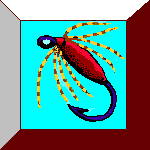


The three genera of the family Caenidae constitute North America's smallest mayflies, with the average size of about 4 mm. Despite their minute dimensions, they are of tremendous importance to the angler. The most significant characteristic of the nymphs are the operculate gills of segment 2, which almost completely cover the ones behind. The nymphs are sprawlers, have three tails, and are densely covered with fine hairs. Adults have whitish, well-developed wings, displaying few crossveins and no marginal intercalary veins. The lateral ocelli are very prominent, and hind wings are absent.
Nymphs of this genus are mainly still-water forms and are, therefore, found to be much more numerous in lakes than in streams. The distinguishing characteristic between the nymphs of Caenis and Tricorythodes is the shape of the operculate gills of segment 2. In Caenis, they are quadrilateral rather than triangular. Lack of the knoblike projections on the head differentiate them from Brachycercus. The adult bodies are light in coloration, varying from whitish, to buff, to yellowish. Their wings have fewer crossveins than Tricorythodes or Brachycercus.